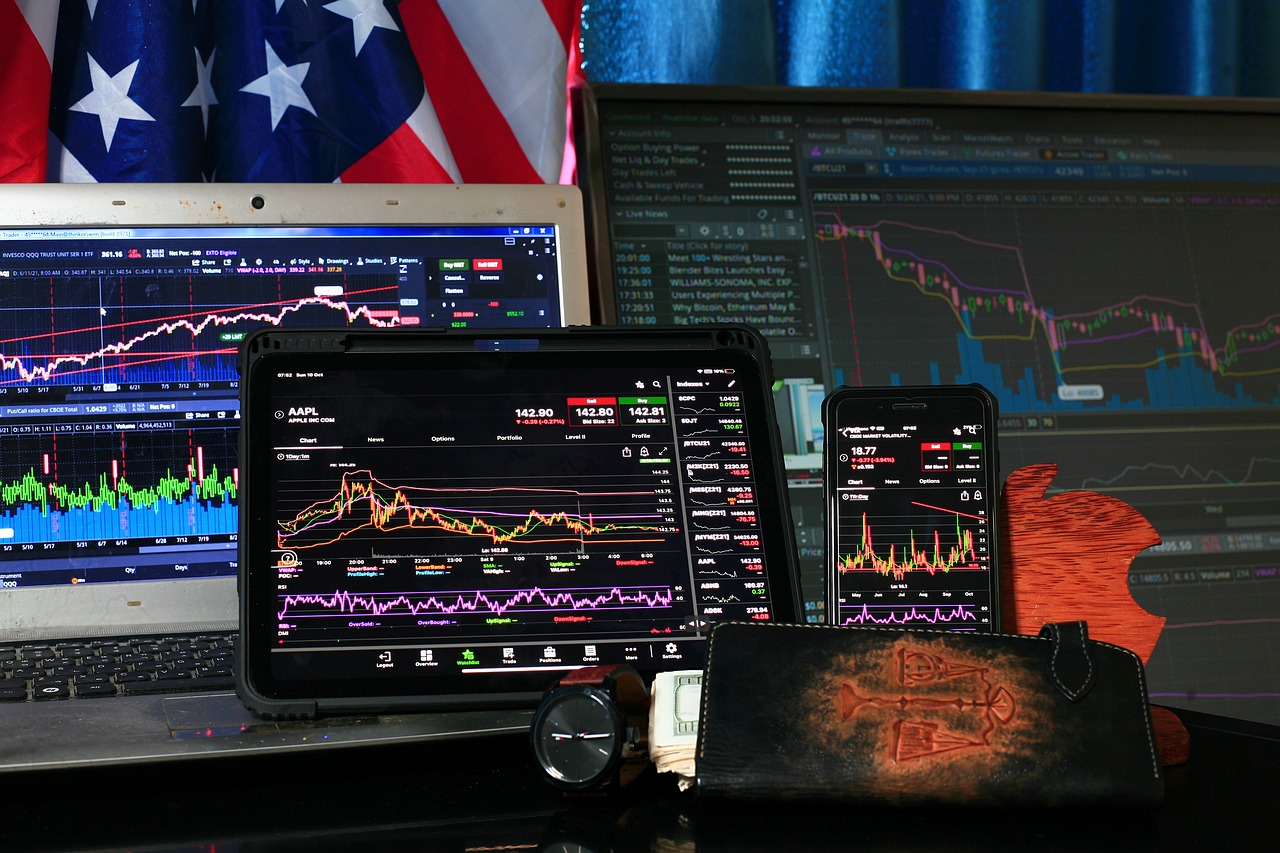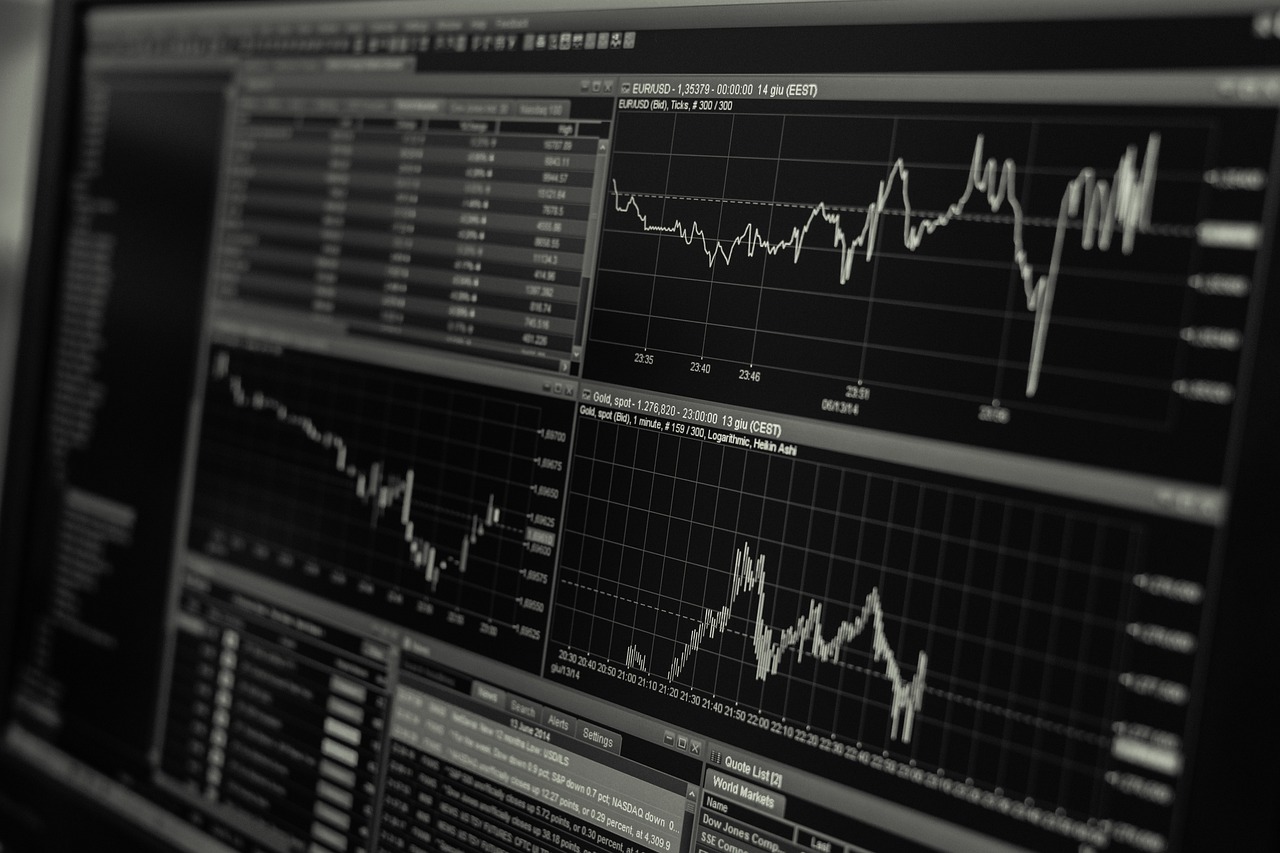Understanding the Psychology Behind Market Trends in Crypto
The world of cryptocurrency is not just about numbers and charts; it's a vibrant tapestry woven from the threads of human emotions, perceptions, and psychological triggers. As we dive into the intricate dance of market trends, it becomes clear that understanding the psychological factors driving these trends is paramount for investors. Think of the crypto market as a massive ocean, where waves of sentiment can either lift you to new heights or pull you under. This article explores how investor behavior, market sentiment, and cognitive biases play pivotal roles in shaping the crypto landscape.
Investor sentiment is like the weather in the crypto world—ever-changing and often unpredictable. When the market is buzzing with optimism, prices can soar to unimaginable heights. Conversely, when fear takes hold, even the most promising projects can plummet. But what exactly drives these emotions? Understanding how feelings of excitement or dread influence buying and selling decisions can offer valuable insights into market movements. For instance, during a bull run, the thrill of potential profits can lead to a rush of buying, while a sudden downturn might trigger panic selling. Recognizing these emotional responses is crucial for any trader looking to make informed decisions.
Cognitive biases are like blindfolds that can obscure an investor's judgment in the crypto market. These biases can lead to irrational behaviors that cloud decision-making. For example, the confirmation bias leads traders to seek out information that supports their existing beliefs while ignoring contradictory evidence. This can result in a skewed perception of a cryptocurrency's potential. Similarly, anchoring bias can cause investors to fixate on a specific price point, making them reluctant to sell even when market conditions indicate otherwise. By identifying these biases, investors can develop a more rational approach to trading, reducing the likelihood of costly mistakes.
Two powerful psychological drivers in the crypto market are Fear of Missing Out (FOMO) and Fear, Uncertainty, and Doubt (FUD). FOMO can lead to impulsive buying decisions as investors rush to capitalize on perceived opportunities. Imagine standing in line for a concert ticket, only to realize that the show is sold out. That anxiety can push people to make hasty choices. On the flip side, FUD can create a wave of panic, leading to mass sell-offs. Understanding these emotional triggers can help investors remain calm amidst the chaos, allowing for more strategic decision-making.
Herd behavior is another prevalent phenomenon in crypto trading. Just as sheep follow the flock, many investors tend to mimic the actions of others, often disregarding their own analysis. This behavior can lead to price bubbles, where the value of a cryptocurrency skyrockets due to collective enthusiasm, only to crash when the crowd disperses. The key takeaway here is the importance of critical thinking. Instead of being swept away by the tide, investors should strive to make independent decisions based on thorough research.
Risk aversion is a common trait among investors, especially in the volatile world of crypto. Many traders are understandably hesitant to put their money on the line, fearing significant losses. However, understanding how risk perception influences investment strategies can be a game-changer. It’s essential to strike a balance between caution and opportunity. By educating themselves about risk management techniques, investors can navigate the turbulent waters of cryptocurrency with greater confidence.
In today’s digital age, social media platforms have transformed the way information spreads in the crypto market. News travels at lightning speed, and a single tweet can send prices soaring or crashing. Analyzing the influence of social media on investor sentiment and decision-making reveals a lot about market dynamics. For example, a viral post about a new project can create a wave of excitement, leading to increased buying activity. Conversely, negative news can incite fear and uncertainty. Investors must learn to discern credible information from mere hype, ensuring that their decisions are informed rather than impulsive.
Conducting thorough market analysis is essential for understanding trends in the crypto space. This involves examining both technical and fundamental factors that can influence prices. A well-rounded analysis not only considers the numbers but also incorporates psychological aspects that drive market behavior. By combining these approaches, investors can develop a comprehensive view of potential market movements, enhancing their decision-making processes.
Technical analysis relies heavily on historical price data and patterns. However, understanding the psychological aspects behind these patterns can significantly enhance traders' predictive capabilities. For instance, recognizing that a certain price level has historically acted as support or resistance can inform trading strategies. By grasping the collective psychology of market participants, traders can better anticipate potential price movements and adjust their strategies accordingly.
Fundamental analysis focuses on the intrinsic value of cryptocurrencies, examining factors such as technology, team, and market demand. However, it’s crucial to explore how market sentiment influences these fundamental factors. For example, a positive shift in sentiment can drive demand, impacting the perceived value of a cryptocurrency. By understanding this relationship, investors can gain a more comprehensive view of the market, enabling them to make informed decisions that align with both technical and fundamental analysis.
- What is the significance of investor sentiment in crypto trading? Investor sentiment can significantly influence market trends, driving prices up or down based on collective emotions.
- How do cognitive biases affect trading decisions? Cognitive biases can lead to irrational behaviors, causing traders to make poor investment choices based on emotions rather than facts.
- Why is risk aversion common among crypto investors? The volatile nature of cryptocurrency can make investors hesitant to take risks, often leading to missed opportunities.
- How does social media impact the crypto market? Social media can rapidly disseminate information, influencing investor sentiment and decision-making, often leading to swift market movements.

The Role of Investor Sentiment
Investor sentiment is like the heartbeat of the cryptocurrency market; it pulses with emotions, perceptions, and collective attitudes that can sway prices dramatically. When we talk about investor sentiment, we’re diving into the realm of psychology where emotions often overshadow rational analysis. Imagine a rollercoaster ride where the highs and lows are dictated not just by numbers but by the feelings of traders. This emotional landscape is crucial for understanding why the market behaves the way it does.
At the core of investor sentiment lies the idea that emotions can drive market trends. When the market is buzzing with excitement, prices tend to rise as more people jump on the bandwagon, driven by the fear of missing out. Conversely, during periods of uncertainty or fear, prices can plummet as investors panic and sell off their assets. It’s a classic case of herd mentality, where individuals often follow the crowd rather than making independent decisions based on sound analysis. This behavior can lead to significant market fluctuations that seem irrational at first glance.
To further understand the impact of investor sentiment, let’s break down some key emotional drivers:
- Optimism: When investors feel positive about the future of a cryptocurrency, they are more likely to buy, pushing prices up.
- Pessimism: Conversely, when the mood turns sour, investors may panic and sell, leading to price declines.
- Fear of Missing Out (FOMO): This powerful emotion can lead to hasty decisions, often resulting in buying at peak prices.
- Fear, Uncertainty, and Doubt (FUD): Negative news can spread like wildfire on social media, causing widespread selling.
These emotional states are not just fleeting feelings; they create a ripple effect throughout the market. For instance, when a major news outlet reports a significant development in a cryptocurrency project, it can ignite a wave of optimism, causing prices to surge. On the flip side, negative news can lead to a rapid sell-off, as investors rush to mitigate their losses. This interplay between news and sentiment highlights the importance of staying informed and aware of the broader market context.
Moreover, the advent of social media has amplified the effects of investor sentiment. Platforms like Twitter, Reddit, and Telegram have become battlegrounds for opinions where sentiment can shift in an instant. A single tweet from a prominent figure can send prices soaring or crashing within minutes. This rapid dissemination of information underscores the need for investors to be vigilant and discerning, separating genuine insights from hype.
In conclusion, understanding investor sentiment is essential for navigating the unpredictable waters of the cryptocurrency market. It’s not just about analyzing charts and numbers; it’s about grasping the emotions that drive those numbers. By recognizing the psychological factors at play, investors can make more informed decisions and potentially capitalize on market trends rather than being swept away by them.

Cognitive Biases in Crypto Trading
Cognitive biases are like the hidden gremlins of the trading world. They lurk in the shadows, subtly influencing our decisions without us even realizing it. In the high-stakes realm of cryptocurrency, where prices can swing wildly in a matter of minutes, understanding these biases is crucial for any investor. After all, the crypto market is not just about numbers and charts; it’s also about the psychology of the people behind those trades. So, let’s dive into some of the most common cognitive biases that can lead investors astray.
One of the most notorious biases is confirmation bias. This occurs when traders only seek out information that confirms their pre-existing beliefs, ignoring any data that might contradict them. Imagine you’re convinced that Bitcoin is going to skyrocket. You might only read articles that support this notion while disregarding the warnings of market analysts who suggest otherwise. This selective perception can lead to disastrous investment choices, especially in a market as unpredictable as crypto.
Another significant bias is anchoring. This is when traders fixate on a specific price point, often the price at which they purchased their assets, and use it as a reference for future decisions. For instance, if you bought Ethereum at $2,000, you might stubbornly hold onto it, hoping it will return to that price, even if market conditions suggest otherwise. This can prevent you from making rational decisions based on current market trends and data.
Then there’s the overconfidence bias. Many traders believe they have a better grasp of the market than they actually do. This overestimation of one’s knowledge can lead to reckless trading decisions. It’s like thinking you can drive a race car just because you’ve played racing video games—real-world experience is a different ball game! In crypto, this bias may encourage investors to take on excessive risks, ultimately leading to significant losses.
Additionally, we can’t ignore the impact of loss aversion. This bias suggests that the pain of losing money is psychologically more powerful than the pleasure of gaining it. In the crypto market, where volatility is the name of the game, this can lead to panic selling. For example, if the market dips, a loss-averse trader might sell off their assets in a frenzy, fearing further losses, even when it may not be the best decision in the long run.
Understanding these biases is essential for developing a more rational trading strategy. Here’s a quick overview of some common cognitive biases in crypto trading:
| Cognitive Bias | Description |
|---|---|
| Confirmation Bias | Seeking information that confirms existing beliefs while ignoring contradictory data. |
| Anchoring | Fixating on a specific price point as a reference for future decisions. |
| Overconfidence Bias | Overestimating one’s knowledge and ability to predict market movements. |
| Loss Aversion | Experiencing the pain of losses more intensely than the joy of gains. |
By recognizing these biases, traders can take steps to mitigate their effects. This might involve implementing a structured trading plan, setting predefined entry and exit points, or even consulting with a trading mentor. Just as a skilled sailor navigates through stormy seas, a savvy trader can steer clear of the pitfalls created by cognitive biases.
In conclusion, while cognitive biases can cloud judgment and lead to poor decisions, awareness is the first step toward overcoming them. By understanding how these psychological factors influence trading behavior, investors can make more informed choices and navigate the tumultuous waters of the cryptocurrency market with greater confidence.
- What are cognitive biases? Cognitive biases are systematic patterns of deviation from norm or rationality in judgment, which can affect decision-making.
- Why are cognitive biases important in crypto trading? They can lead to irrational decisions that negatively impact investment outcomes.
- How can I mitigate cognitive biases while trading? By implementing a structured trading plan, setting clear goals, and seeking external advice.

In the fast-paced world of cryptocurrency, two acronyms often dominate discussions and decision-making: FOMO (Fear of Missing Out) and FUD (Fear, Uncertainty, and Doubt). These psychological phenomena are not just buzzwords; they are powerful emotional forces that can dramatically sway market trends. Imagine standing at the edge of a cliff, watching a massive wave of investors rushing into the ocean of opportunity while you hesitate. That’s FOMO in action. It’s that gut-wrenching feeling that if you don’t act now, you’ll miss out on potential profits, pushing you to make hasty decisions without fully understanding the risks involved.
On the flip side, FUD operates like a shadowy figure lurking in the background, whispering doubts and fears into the ears of investors. When negative news or rumors circulate, they can create a chilling effect on the market, leading to panic selling. Think of it as a game of telephone where one person’s fear can ripple through the community, amplifying anxiety and uncertainty. A single tweet or news article can send the price of a cryptocurrency tumbling, as investors react to the perceived threat rather than the actual situation. This reactionary behavior can lead to significant market volatility, creating a cycle of fear and impulsive actions.
Understanding these psychological drivers is crucial for any investor looking to navigate the turbulent waters of crypto trading. The interplay between FOMO and FUD can create a feedback loop that influences not only individual decisions but also broader market trends. For instance, during a bull market, FOMO can lead to a surge in buying activity, inflating prices beyond their intrinsic value. Conversely, in a bear market, FUD can trigger widespread panic, causing prices to plummet as investors rush to sell their holdings.
To illustrate the impact of FOMO and FUD, consider the following table that summarizes their effects on investor behavior:
| Emotion | Effect on Behavior | Market Impact |
|---|---|---|
| FOMO | Encourages impulsive buying | Price increases, potential bubbles |
| FUD | Triggers panic selling | Price decreases, market crashes |
In conclusion, FOMO and FUD are not just emotional responses; they are integral components of the psychological landscape that shapes the cryptocurrency market. By recognizing these influences, investors can better equip themselves to make informed decisions, mitigating the irrational behaviors that often accompany these powerful emotions. So, the next time you feel the urge to jump into a trade out of fear of missing out or react to negative news, take a step back. Ask yourself: Are these emotions guiding my decisions, or am I making a rational choice based on sound analysis?
- What is FOMO in cryptocurrency? FOMO refers to the fear of missing out on profitable opportunities, often leading to impulsive buying decisions.
- How does FUD affect the crypto market? FUD generates fear and uncertainty, causing investors to sell off their assets, which can lead to significant price drops.
- Can understanding FOMO and FUD improve trading strategies? Yes, by recognizing these psychological factors, traders can make more informed and rational decisions, reducing the impact of emotional trading.

Herd behavior in the cryptocurrency market is like a double-edged sword; it can lead to both exhilarating highs and devastating lows. Imagine a flock of birds taking flight; when one bird swoops up, the rest follow suit, often without understanding why. In the crypto world, this phenomenon manifests when traders make decisions based on the actions of others rather than their own analysis or intuition. This behavior is particularly pronounced in a market as volatile as cryptocurrency, where emotions run high and the fear of missing out (FOMO) can create a bandwagon effect.
When prices start to rise, the excitement builds, and suddenly everyone wants a piece of the pie. This rush can inflate prices to unsustainable levels, creating what we often refer to as a "bubble." Conversely, when prices start to fall, panic sets in, and traders rush to sell, further driving down the price. This cycle of buying and selling creates a feedback loop that can lead to extreme market fluctuations. Understanding herd behavior is crucial for any investor looking to navigate the unpredictable waters of cryptocurrency trading.
So, what drives this herd mentality? Several psychological factors come into play:
- Social Proof: People often look to others to gauge what is acceptable or desirable, leading to a collective mindset.
- Fear and Anxiety: In a market characterized by uncertainty, individuals may feel safer following the crowd rather than making independent decisions.
- Desire for Acceptance: The need to belong can push individuals to conform to the actions of the majority, even if those actions may not align with their own beliefs.
This herd mentality can lead to significant market distortions. Investors may overlook fundamental analyses and technical indicators in favor of what the majority is doing, which can result in poor decision-making. For instance, during the 2017 Bitcoin boom, many new investors jumped in without understanding the underlying technology or market dynamics, simply because they saw others profiting.
To combat herd behavior, it’s essential for traders to cultivate a sense of self-awareness and critical thinking. Instead of following the crowd, they should focus on their own research and strategies. This approach not only helps in making informed decisions but also reduces the emotional turmoil that often accompanies trading. By developing a disciplined trading strategy and sticking to it, investors can better navigate the unpredictable nature of the crypto market.
In summary, while herd behavior is an inherent part of human psychology, especially in volatile markets like cryptocurrency, recognizing and mitigating its effects can empower investors. By understanding the psychological triggers that lead to herd behavior, traders can make more rational decisions, ultimately enhancing their trading outcomes.
- What is herd behavior in cryptocurrency? Herd behavior refers to the tendency of individuals to follow the actions of a larger group, often leading to irrational decision-making in trading.
- How can I avoid falling into herd behavior? Focus on conducting your own research, develop a trading strategy, and remain disciplined in your decision-making process.
- Why is herd behavior more pronounced in crypto markets? The high volatility and emotional nature of cryptocurrency trading amplify feelings of FOMO and panic, making herd behavior more prevalent.

Risk aversion is a prevalent trait among investors, particularly in the unpredictable world of cryptocurrency. Imagine standing on the edge of a diving board, peering down at the swirling waters below. The fear of jumping into the unknown can be overwhelming, but for some, the thrill of the plunge is worth the risk. In the crypto market, however, many investors choose to stay on the board, hesitant to dive into investments that could lead to both substantial gains and devastating losses.
Understanding the psychology behind risk aversion can shed light on why many traders hesitate to embrace the volatility of cryptocurrencies. The fear of losing money often outweighs the potential for profit, leading to a cautious approach that can stifle growth. This behavior is not just instinctual; it's deeply rooted in our cognitive processes. When faced with the possibility of loss, our brains tend to react more strongly than when we consider potential gains, a phenomenon known as loss aversion.
In the context of cryptocurrency, this risk aversion can manifest in several ways:
- Holding onto investments: Investors may cling to underperforming assets, hoping for a rebound instead of cutting their losses and reallocating their capital.
- Missed opportunities: Fear can prevent investors from seizing profitable opportunities, as they may hesitate to invest in a new cryptocurrency due to uncertainty.
- Over-diversification: In an attempt to mitigate risk, some investors spread their capital too thin across various assets, which can dilute potential returns.
Moreover, the emotional rollercoaster that accompanies trading in such a volatile market can exacerbate risk aversion. The constant fluctuations in prices can lead to heightened anxiety, making it even more challenging for investors to make rational decisions. It's like being on a thrilling amusement park ride—while some revel in the excitement, others may find themselves gripping the safety bar, paralyzed by fear.
To combat risk aversion, investors can adopt several strategies:
- Education: Gaining a deeper understanding of the market can empower investors to make informed decisions, reducing the fear of the unknown.
- Setting clear goals: By establishing specific investment objectives, traders can maintain focus and minimize emotional responses to market fluctuations.
- Practicing mindfulness: Techniques such as meditation can help investors manage anxiety and approach trading with a clearer mindset.
Ultimately, while risk aversion is a natural response to the unpredictable nature of cryptocurrency, recognizing and addressing this psychological barrier is crucial for any investor. By understanding the driving forces behind their decisions, traders can navigate the treacherous waters of the crypto market with greater confidence and clarity.
- What is risk aversion in cryptocurrency trading?
Risk aversion refers to the tendency of investors to prefer avoiding losses rather than acquiring equivalent gains, which can lead to conservative investment strategies. - How can I overcome my risk aversion?
Educating yourself about the market, setting clear investment goals, and practicing mindfulness can help mitigate risk aversion. - Why is risk aversion common among crypto investors?
The volatile nature of the cryptocurrency market can create significant emotional stress, leading many investors to prioritize safety over potential gains.

In today's digital age, social media has become a powerful catalyst in shaping the cryptocurrency landscape. Platforms like Twitter, Reddit, and Telegram have transformed the way information is disseminated and consumed, creating a dynamic environment where sentiment can shift rapidly. Have you ever noticed how a single tweet can send a cryptocurrency soaring or crashing within minutes? This phenomenon is not just a coincidence; it's a testament to the profound influence social media has on investor behavior.
The rapid spread of information on social media can lead to a phenomenon known as viral sentiment. When a particular cryptocurrency gains traction online, it can spark a wave of interest and investment, often referred to as a "hype cycle." This cycle can create a self-fulfilling prophecy, where the more people talk about a coin, the more others feel compelled to buy in. However, this can also lead to irrational exuberance—a term that describes the over-enthusiasm of investors that can inflate prices beyond their intrinsic value.
On the flip side, social media can also be a breeding ground for fear, uncertainty, and doubt (FUD). Negative news or rumors can spread just as quickly, leading to panic selling and market downturns. For instance, when influential figures or major accounts express skepticism about a cryptocurrency, it can trigger a wave of sell-offs, causing prices to plummet. This highlights the double-edged sword nature of social media in the crypto world.
Understanding the impact of social media on market trends requires a closer look at how these platforms function. Here are a few key aspects:
- Real-Time Information: Investors can receive updates instantly, making them more reactive to market changes.
- Community Influence: Online communities often form around specific cryptocurrencies, creating a sense of belonging and shared purpose that can amplify market movements.
- Accessibility of Information: Anyone can share their opinions, which democratizes information but also leads to the spread of misinformation.
The influence of social media on investor sentiment is undeniable. As traders, it’s crucial to navigate this landscape with a critical eye. Instead of getting swept up in the frenzy, taking a step back to analyze the information and its sources can be a valuable strategy. Remember, just because something is trending doesn't mean it’s a sound investment.
In conclusion, while social media can provide valuable insights and foster community engagement, it’s essential to approach it with caution. The emotional highs and lows it can evoke may lead to irrational decision-making—a risk that every investor should be aware of. By understanding the psychological impact of social media, traders can better position themselves in this volatile market.
- How does social media influence cryptocurrency prices?
Social media can create viral sentiment, leading to rapid price increases or decreases based on public perception and emotional reactions. - What is FUD in crypto?
FUD stands for fear, uncertainty, and doubt. It refers to negative information spread to create panic and drive prices down. - Should I trust social media for investment advice?
While social media can provide insights, it’s important to verify information and consider multiple sources before making investment decisions.

When it comes to navigating the tumultuous waters of cryptocurrency, market analysis is your compass. Why? Because understanding market trends is not just about crunching numbers; it’s about interpreting the emotions and behaviors that drive those numbers. Picture this: you're in a crowded marketplace, and everyone is shouting about the latest hot item. How do you decide what to buy? This is precisely how traders feel in the crypto space, where emotions often overshadow rational decision-making.
Market analysis serves as a crucial tool for investors, helping them sift through the noise and focus on what truly matters. It’s akin to having a roadmap in a city you’ve never visited before. By employing various analytical approaches, traders can gain insights into potential price movements and market sentiment. Let’s delve into the two primary types of market analysis: technical analysis and fundamental analysis.
Technical analysis is like reading the pulse of the market through historical price data and patterns. By analyzing charts and indicators, traders can identify trends and potential reversal points. But here’s the kicker: the psychology behind these patterns is what really matters. For instance, when a price approaches a significant resistance level, traders often feel a mix of excitement and fear. This emotional cocktail can lead to predictable behaviors, such as panic selling or exuberant buying. Understanding these psychological aspects can significantly enhance a trader’s predictive capabilities.
On the other hand, fundamental analysis digs deeper into the intrinsic value of cryptocurrencies. It examines factors like technology, team credibility, market demand, and regulatory environment. But how does market sentiment play into this? Well, let’s say a new blockchain project is launched with great technological promise. If the overall sentiment is negative due to recent market crashes, even the most revolutionary projects might struggle to gain traction. This interplay between fundamental factors and market sentiment is essential for a comprehensive understanding of potential market movements.
Investors should not only rely on one analysis method but rather combine both technical and fundamental approaches for a well-rounded view. It’s like having a toolbox: each tool serves a different purpose, but together they help you build a sturdy structure. In the world of crypto, where volatility reigns supreme, combining these analyses can help mitigate risks and identify opportunities.
| Type of Analysis | Description | Psychological Implications |
|---|---|---|
| Technical Analysis | Analyzing historical price data and market patterns. | Emotional reactions to price movements can lead to predictable behaviors. |
| Fundamental Analysis | Evaluating the intrinsic value of cryptocurrencies based on various factors. | Market sentiment can overshadow fundamental value, affecting investment decisions. |
In conclusion, the importance of market analysis in cryptocurrency cannot be overstated. By understanding both technical and fundamental aspects, investors can make informed decisions that are less influenced by fleeting emotions. Remember, it’s not just about what the market is doing but why it’s doing it. So, the next time you find yourself in the crypto marketplace, arm yourself with the insights from thorough market analysis, and you might just find your way through the chaos.
- What is market analysis in cryptocurrency? Market analysis involves evaluating market trends and investor behavior to make informed trading decisions.
- Why is technical analysis important? Technical analysis helps traders identify price patterns and potential market movements based on historical data.
- How does market sentiment affect cryptocurrency prices? Market sentiment can lead to irrational buying or selling, significantly impacting price fluctuations.
- Can I rely solely on fundamental analysis? While fundamental analysis is crucial, combining it with technical analysis provides a more comprehensive view of the market.

When diving into the world of cryptocurrency trading, technical analysis is often seen as a crucial tool for traders. But did you know that the psychology behind this analysis can be just as important as the numbers themselves? Technical analysis is not merely about charts and graphs; it’s about understanding the human emotions that drive market movements. Traders often rely on historical price data and patterns to predict future price movements, yet their interpretations of these patterns can be heavily influenced by their psychological state.
For instance, consider the concept of support and resistance levels. These are key price points where the market tends to reverse direction. However, the way traders react when approaching these levels is often dictated by their emotions. A trader who has experienced a loss may view a support level with skepticism, fearing another downturn, while an optimistic trader may see it as a buying opportunity. This divergence illustrates how psychological factors can skew the interpretation of technical indicators, leading to varied trading decisions.
Moreover, the concept of trends plays a significant role in technical analysis. Traders often look for trends—upward, downward, or sideways—to make decisions. But what happens when a trader is overly confident in a trend? This overconfidence can lead to a phenomenon known as the bandwagon effect, where traders buy into a rising market without considering potential risks. This can inflate prices beyond sustainable levels, creating a bubble that is bound to burst when reality sets in. Understanding the psychology of trends can help traders avoid falling into this trap.
To further illustrate the impact of psychology in technical analysis, let’s examine the following table that highlights common psychological biases affecting traders:
| Psychological Bias | Description | Impact on Trading |
|---|---|---|
| Confirmation Bias | The tendency to favor information that confirms existing beliefs. | Leads to ignoring contradictory data, potentially resulting in poor investment decisions. |
| Overconfidence Bias | When traders overestimate their knowledge or ability to predict market movements. | Can lead to excessive risk-taking and significant losses. |
| Loss Aversion | The fear of losing money outweighs the desire to make money. | May cause traders to hold onto losing positions for too long, hoping for a turnaround. |
As you can see, these biases can cloud judgment and lead to irrational trading behaviors. Being aware of these psychological factors is crucial for anyone looking to improve their trading strategies. By recognizing the emotions that accompany trading decisions, investors can better navigate the often unpredictable waters of the crypto market.
In conclusion, technical analysis is not just a numbers game; it’s a complex interplay of data and human emotion. By understanding the psychological aspects behind technical analysis, traders can enhance their decision-making processes, leading to more informed and rational trading strategies. So, the next time you look at a chart, remember that behind every price movement is a story of human behavior, filled with hopes, fears, and biases.
- What is technical analysis? Technical analysis involves analyzing historical price data and patterns to predict future price movements.
- How do emotions affect trading decisions? Emotions can lead to biases that skew judgment, resulting in poor trading choices.
- Can psychological biases be overcome? Yes, by increasing awareness of these biases, traders can develop strategies to mitigate their effects.

This article explores the psychological factors driving market trends in cryptocurrency, examining investor behavior, market sentiment, and the cognitive biases that influence decision-making in this volatile environment.
Investor sentiment plays a crucial role in shaping market trends. Understanding how emotions and perceptions influence buying and selling decisions can provide insights into market movements and potential future trends.
Cognitive biases significantly impact trading decisions in the crypto market. Identifying these biases helps investors recognize irrational behaviors that may lead to poor investment choices and market misjudgments.
Fear of missing out (FOMO) and fear, uncertainty, and doubt (FUD) are powerful psychological drivers in crypto. These emotions can lead to irrational buying or selling, affecting overall market dynamics.
Herd behavior is prevalent in crypto trading, where individuals follow the crowd rather than making independent decisions. This can lead to price bubbles and crashes, highlighting the need for critical thinking.
Risk aversion is a common trait among investors, especially in volatile markets like crypto. Understanding how risk perception influences investment strategies can help traders navigate potential pitfalls.
Social media platforms have transformed how information spreads in the crypto market. Analyzing the influence of social media on investor sentiment and decision-making can reveal trends and potential market shifts.
Conducting thorough market analysis is essential for understanding trends. This section discusses various analytical approaches, including technical and fundamental analysis, and their psychological implications for investors.
Technical analysis relies on historical price data and patterns. Understanding the psychological aspects behind these patterns can enhance traders' predictive capabilities and improve their decision-making processes.
Fundamental analysis focuses on the intrinsic value of cryptocurrencies, taking into account various factors such as technology, team expertise, and market demand. However, it is essential to recognize that market sentiment can significantly influence these fundamental factors. For instance, a positive news cycle can lead to increased interest and investment in a cryptocurrency, thereby elevating its perceived value, even if the underlying fundamentals have not changed. This interplay between sentiment and fundamentals can create a volatile environment where prices do not always reflect true value.
Moreover, understanding market sentiment involves analyzing how external events, news, and social media can sway investor perceptions. For example, when a prominent figure in the crypto space endorses a particular coin, it can trigger a surge in buying activity, propelled by the excitement and optimism of potential profits. Conversely, negative news, such as regulatory crackdowns or security breaches, can create panic and lead to significant sell-offs.
To illustrate this relationship, consider the following table that summarizes how different factors affect market sentiment:
| Factor | Impact on Market Sentiment |
|---|---|
| Positive News | Increases buying interest and optimism |
| Negative News | Leads to panic selling and fear |
| Celebrity Endorsements | Boosts confidence and market activity |
| Regulatory Changes | Creates uncertainty and cautious behavior |
In conclusion, while fundamental analysis provides a solid foundation for understanding the value of cryptocurrencies, market sentiment can often overshadow these fundamentals. Investors must remain vigilant and consider both aspects when making trading decisions. Balancing fundamental insights with an awareness of market sentiment can lead to more informed and strategic investment choices.
- What is fundamental analysis in cryptocurrency? It is the evaluation of a cryptocurrency's intrinsic value based on factors like technology, team, and market demand.
- How does market sentiment affect cryptocurrency prices? Market sentiment can drive prices up or down based on emotions, news, and social media influence, often independent of the underlying fundamentals.
- Why is understanding investor psychology important? Recognizing psychological factors can help investors avoid common pitfalls and make more rational trading decisions.
Frequently Asked Questions
- What is the role of investor sentiment in cryptocurrency markets?
Investor sentiment is a powerful force that shapes market trends in the crypto space. Emotions like excitement, fear, and uncertainty can drive buying and selling decisions, often leading to significant price fluctuations. By understanding these emotional drivers, investors can gain insights into potential market movements and make more informed decisions.
- How do cognitive biases affect trading decisions?
Cognitive biases, such as overconfidence and loss aversion, can lead investors to make irrational decisions. For instance, a trader may hold onto a losing investment longer than they should due to the fear of realizing a loss. Recognizing these biases can help investors avoid common pitfalls and develop a more rational approach to trading.
- What are FOMO and FUD, and how do they impact the market?
FOMO, or fear of missing out, drives investors to buy into rising markets without proper analysis, while FUD, or fear, uncertainty, and doubt, can cause panic selling during downturns. Both emotions can create extreme volatility and lead to poor investment decisions, making it crucial for traders to stay grounded and stick to their strategies.
- Why is herd behavior significant in crypto trading?
Herd behavior occurs when investors follow the crowd, often leading to price bubbles or crashes. This behavior highlights the importance of independent thinking and analysis. By understanding the psychological factors behind herd behavior, traders can better navigate the market and make more strategic choices.
- How does social media influence cryptocurrency markets?
Social media platforms have become major channels for information dissemination in the crypto world. They can amplify market sentiment, causing rapid shifts in investor behavior. Monitoring social media trends can provide valuable insights into potential market movements and help investors stay ahead of the curve.
- What is the difference between technical and fundamental analysis?
Technical analysis focuses on historical price patterns and trading volumes to predict future price movements, while fundamental analysis examines the intrinsic value of cryptocurrencies based on factors like technology, use case, and market demand. Both approaches have psychological implications, as they reflect investor sentiment and behavior.
- How can understanding market psychology improve trading strategies?
By grasping the psychological factors at play, traders can better anticipate market movements and make more informed decisions. Understanding emotions, biases, and social influences can enhance a trader's ability to navigate the volatile crypto landscape and potentially increase their success rate.



















